Resolutions that connect you with nature
- Spend more time outdoors
Spending time in nature has been shown to reduce stress and have a positive impact on both your physical and mental health. Clocking more time outside can be as simple as taking a quick walk around your neighborhood, visiting local parks, or by doing some daily tasks outdoors. For example, you can try exercising, eating your lunch, and taking phone calls outside. You don’t need to hike for hours to experience the physical and mental benefits of getting outdoors–take a break and head outside! - Explore more in 2024
With beaches, wetlands, forests, mountains, and more, break out of your normal routine and explore a new place in Massachusetts. MassWildlife manages nearly 230,000 acres of Wildlife Management Areas that provide habitat for wildlife and give people a place to explore natural landscapes (there are no maintained trails). WMAs are open to the public for hunting, fishing, wildlife watching, hiking, wildlife photography, snowshoeing, cross-country skiing, and other passive recreation. Use MassWildlife’s Lands Viewer to find a property near you. - Try a new hobby
Broaden your horizons with a new hobby. Fishing, hunting, wildlife viewing, and other outdoor recreation are great ways to connect with nature and learn a new skill. MassWildlife has resources to help you get started.
- Get started with wildlife viewing. You don’t have to travel far to experience the impressive variety of Massachusetts Wildlife. Check out these wildlife viewing tips and tools or get started birding this year with 5 must-read tips for bird watching in winter.
- Gain a deeper appreciation for Massachusetts wildlife by learning to identify animal tracks. Use MassWildlife’s animal track card as a guide to tracks you find in the snow or mud this winter.
- Learn how to fish! Bookmark MassWildlife’s Angler Education calendar to find a freshwater fishing class near you—classes will be added throughout the year. You can also learn fishing on your own using these online learning resources. Don’t forget your 2024 Freshwater Fishing License.
- Learn to be a safe and ethical hunter with MassWildlife’s Hunter Education Program. Visit the Program web page to learn about course offerings and what’s required to get started hunting in the Commonwealth.
- Be a wildlife ambassador
Help your local wildlife by preventing conflicts. Raccoons, coyotes, black bears, and other local wildlife get a bad reputation because of conflicts with people. Many of these conflicts occur because wild animals are attracted to neighborhoods by human-associated food sources like bird seed, unsecured trash, and pet food. Make a resolution to keep wildlife wild by removing these food sources and preventing conflicts with wildlife in your neighborhood. - Grow more native plants
Native plants are important in preserving the biodiversity of Massachusetts. They provide food for pollinators such as birds, bees, and butterflies and create habitat for our local wildlife. If you are new to gardening or don’t have the greenest of thumbs, native plants are also easier to maintain because they are adapted to our climate and conditions! Get started by choosing native plants based on the type of soil you have available.
Why you shouldn't feed wildlife this winter
Each winter, MassWildlife receives inquiries from the public regarding whether or not to feed wildlife. While people have good intentions, supplemental feeding of wildlife typically does more harm than good. Most wildlife seasonally change their behavior to adapt to cold temperatures and scarce food supplies. Supplemental feeding can alter that behavior and have detrimental, and sometimes fatal, effects. Wildlife in Massachusetts have adapted over thousands of years to cope with harsh winter weather, including deep snow, cold temperatures, and high winds.
Supplemental feed sites congregate wildlife into unnaturally high densities, which can:
- Attract predators and increase risk of death by wild predators or domestic pets;
- Spread diseases among wildlife or cause other health issues (e.g. Rumen acidosis in deer, Aflatoxicosis in turkeys);
- Cause aggression and competition over food, wasting vital energy reserves and potentially leading to injury or death;
- Reduce fat reserves, as wild animals use energy traveling to and from the feeding site;
- Cause wildlife to cross roads more frequently, therefore increasing vehicle collisions;
- Negatively impact vegetation and habitat in areas where feeding congregates animals.
Providing wildlife with food at any time of year teaches them to rely on humans for food, which puts them at a disadvantage for survival and can lead to human/wildlife conflicts. Once habituated behavior is established, it can be very difficult or impossible to change.
What can you do?
The best way to help wildlife make it through the winter is to step back and allow the animals’ instincts to take over. To help wildlife near your home, focus on improving the wildlife habitat on or near your property, by including natural food and cover (e.g., some conifer cover and regenerating forest or brushy habitat). It is also important that wildlife populations are in balance with what the habitat can support.
Bird feeding
MassWildlife biologists advise against feeding wildlife. While backyard bird feeding during winter months is generally acceptable, we recommend using native plants and water to attract birds to your yard. Fallen bird seed can unintentionally attract many types of wildlife, including bears, turkeys, small mammals like squirrels and mice, and predators like foxes, fishers, and coyotes that feed on small mammals. If you notice unwanted wildlife in your backyard, bring in your bird feeders immediately.
Upcoming dam removals will benefit ecosystems and people
MassWildlife plans to remove seven dams that are in poor condition and have outlived their original purpose. All the dams are within Wildlife Management Areas (WMAs) and owned by MassWildlife. The dam removal projects are expected to reduce the risk of flooding and improve aquatic habitats and water quality.
Dams artificially hold back water and change the way a river functions by converting flowing water habitat to still water habitat. They trap sediment and create stagnant conditions with warmer water and lower dissolved oxygen than the rest of the river system. Dams also block the movement of fish and invertebrates, many of which need to access different areas of the watershed during different parts of their life cycle. Many of the dams are located on or are connected to waterways designated as Coldwater Fish Resources. These sensitive habitats are home to populations of reproducing coldwater fish species like brook trout.
Removing these dams will restore stream function which improves biodiversity. This is aligned with MassWildlife’s mission to conserve native fish, wildlife, and habitats across the Commonwealth. Removing aging dams also benefits the people of Massachusetts by reducing safety risks, eliminating the costs associated with ongoing repairs and maintenance, and providing WMA visitors with expanded access to natural landscapes.
The dam removal projects are funded by $5 million from the American Rescue Plan Act (ARPA). Project planning has already begun; construction will start in 2025 and will be complete by June of 2026. Dams slated for removal are Arnold Pond Dam and Schoolhouse Pond Dam in Sutton, Cusky Pond Dam in New Braintree, Patrill Hollow Pond Dam in Hardwick, Salmon Pond Dam in Brookfield, Thousand Acre Reservoir Dam in Athol, and Weston Brook Dam in Windsor. Stay tuned for updates and results from these important restoration projects.
Meet the Massachusetts Mustelids
There are few families of wildlife that are as charismatic as the weasel family. Mustelidae, which includes weasels, minks, martens, badgers, wolverines, and otters, is the largest family in Carnivora with over 50 species spread across every continent except Antarctica and Australia. Mustelids can be found in a variety of habitats, including terrestrial and aquatic environments. One thing Mustelids have in common is their ability to mark their territory with a strong, musty smell. Some members of the weasel family, like otters, are famous for their playful personality and bounding gait.
There are currently 5 species of Mustelids in Massachusetts: fisher, North American river otter, American mink, ermine, and long-tailed weasel. Historically, Massachusetts also had American martens and wolverines but there hasn’t been an established population of either species since the 1800s. Given their similar silhouettes, it can be a challenge to identify which Mustelid you may have spotted. Read the descriptions below to discover the differences between the Massachusetts Mustelids. When you’re ready to test your new knowledge, try identifying the mystery animal in this video!
When identifying an animal, ask yourself:
- What is the approximate size of the animal? An animal can appear larger than it truly is if it’s close to the camera lens!
- How is the animal moving? Does it have a walking, lumbering, bounding, or trotting gait?
- What is the shape of the animal’s face, body, and/or tail?
- What type of habitat did you see the animal in?
Fisher
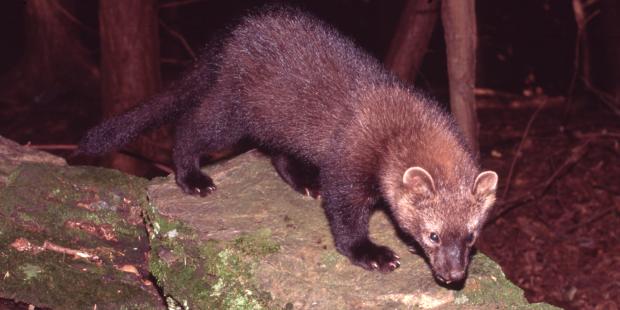
Appearance:
- Length: 2 – 3 ft., tail is about 1/3 of total body length
- Weight: 4 – 16 lbs.
- Rich brown to black fur with grizzled grayish coloring on the head and shoulders, can have white patches of fur on their chest and lower abdomen
- Long, slender body with short legs and furred tail
- Pointed face with large, rounded ears set close to the head
- Sharp, retractable claws that make them well-adapted for climbing trees
Habitat:
- Upland forests
Diet:
- Small rodents, squirrels, rabbits, birds, eggs, fruit, porcupines, and carrion
North American river otter
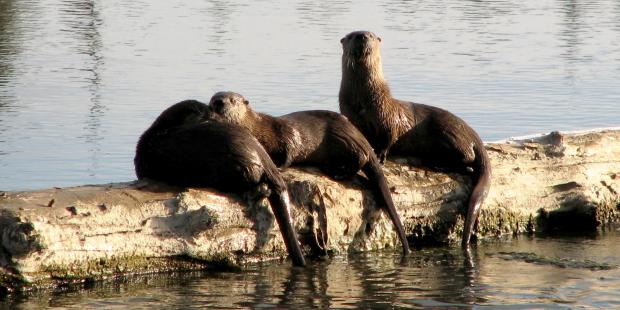
Appearance:
- Length: 3 – 4 ft., tail is about 1/3 of total body length
- Weight: 11 – 30 lbs.
- Dark brown water-repellent coat, a lighter colored belly, and silver-gray throat
- Long, slender body with short legs and webbed feet
- Thick tail that tapers to a point that make them efficient underwater hunters
Habitat:
- Marshes, lakes, rivers, swamps, and estuaries
Diet:
- Fish, crayfish, snakes, frogs, insects, crustaceans, amphibians, and mammals
American mink
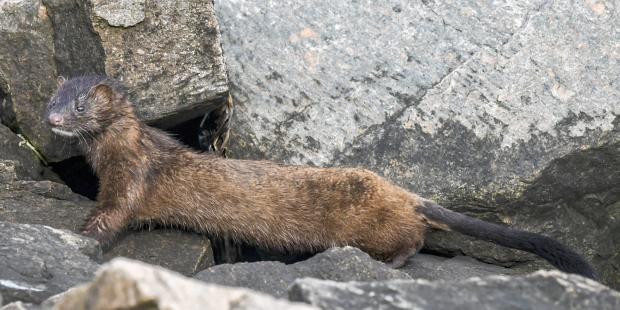
Appearance:
- Length: 1.5 – 2.5 ft., tail is about 1/3 of total body length
- Weight: 2 – 3 lbs.
- Dark brown waterproof coat with a white spot on their chin, occasional white markings on the throat, chest, or belly
- Long, slender body with short legs and partially webbed toes
- Short, rounded ears and a pointed nose
- Moderately bushy, near-black tipped tail
Habitat:
- Lake shores, creeks and streams, swamps, salt and freshwater marshes, and coastlines
Diet:
- Fish, frogs, crustaceans, muskrats, and small mammals
Ermine (short-tailed weasel)
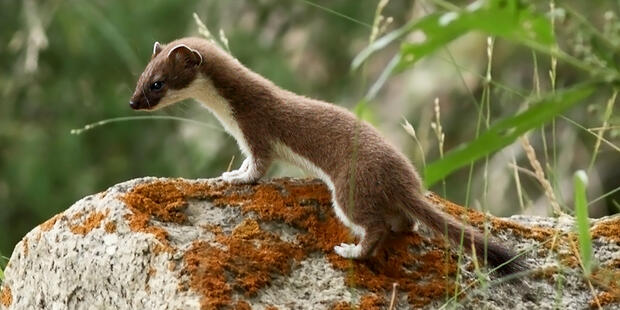
Appearance:
- Length: 6 in. – 1 ft., tail is about 1/3 of total body length
- Weight: 1.3 – 3.7 oz.
- Summer coat has brown fur with white underbelly and black tipped tail, winter coat has white fur with black tipped tail
- Long, slender body with short legs and small rounded ears
- Will move rapidly in a random pattern or burrow beneath the snow when hunting
Habitat:
- Deciduous forests, riparian woodlands, stream banks, forest edges, and rocky areas
Diet:
- Rodents, shrews, rabbits, red squirrels, and insects
Long-tailed weasel
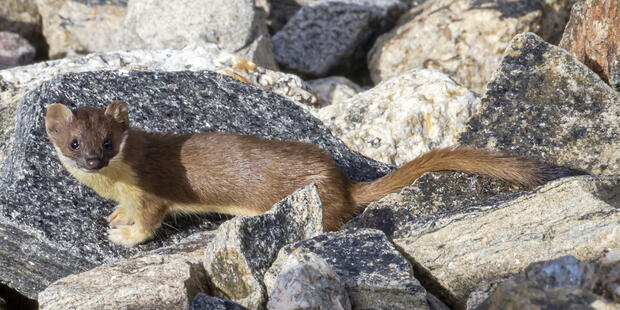
Appearance:
- Length: 1 – 1.5 ft., tail is about 2/3 total body length
- Weight: 3 – 11 oz.
- Summer coat has brown fur with white underbelly and black tipped tail, winter coat has white fur with black tipped tail
- Long, slender body with short legs and small rounded ears
- Long-tailed weasels are more common than ermines in Massachusetts
Habitat:
- Woodlands, brushy areas next to fields, and grassy areas alongside wetlands
Diet:
- Rabbits, snowshoe hare, rodents, shrews, moles, and eggs
How to maintain and store your fishing equipment
The holidays are over, most of the hunting seasons have passed, and the ice has yet to safely form. So, what can you do to keep occupied and stay connected to your outdoor passions? How about organizing and properly stowing away your open water fishing gear? It’s hard to find time to organize, but I have found that taking a little time to care for my gear can really pay off once spring rolls around. Here are a few simple things you can do to keep your fishing gear in tip-top shape.
Rod and reel combinations
Take everything out, remove any terminal tackle (lures or live bait rigs), then take the reel off the rod.
- Rod: Inspect the rod and look for issues like damaged guides or broken reel seats. This kind of damage can be repaired at a tackle shop, or you can browse the many online resources and videos to complete the repairs yourself. If you don’t find damage, wipe down the rod, reel seat, and handle. Put a little lubricating oil on the reel seat threads to keep it from rusting (no need to do this if it’s plastic).
- Reels: Depending on how much you fish, you may decide to change the line. If you only fish a few times each year, this isn’t necessary. If you’re on the water a lot, you should probably strip the line off and re-spool with new line. This is a fairly simple process with oodles of online videos to guide you through. Before storing, decrease the drag setting (line tension adjustor) to reduce strain on the drag gears. Wash the reel gently, especially if it’s been in salt water at all during the year. Wipe it down and lubricate all the moving parts with reel oil.
Reattach the reel to the rod. Store upright or laying down in a spot out of direct sunlight and extreme temperatures—garages and basements work just fine. There’s no need to re-rig the rod and reel with tackle. It’s best for the rod and the moving parts of the reel if you store it un-rigged.
Terminal tackle
Take a look at your terminal tackle–hooks, bobbers, weights, lures etc. Organize your tackle bag or box by removing loose fishing line, broken or rusted lures, pieces of soft plastic lures, cracked bobbers, rusty hooks, and other miscellaneous trash that has accumulated over the year (or years!). Put all the tackle back neatly in whatever arrangement works best for you. I like to keep things separated—live bait gear including hooks, bobbers, and weights are close together and lures are stored in a different area and organized by style or by target species. Always keep soft plastics in their original packaging, as these can melt or chemically bind to other plastic materials within your box.
Fishing tools
I don’t pack a ton of tools, but the ones I do carry are indispensable—a hook removal tool, nail clippers, a good knife, and perhaps a stringer and or a mouth gripping tool. It’s frustrating when you reach for those hemostats to remove a hook and they’re rusted solid and won’t move. Clean up your fishing tools and make sure they’re in good working order. If a tool is rusted solid and hasn’t been used in years, it might be a good idea to just toss it. However, if it’s only a bit of surface rust, a light sanding with steel wool and some lubricating oil should bring it back to life. Make sure to replace any tools you need before heading out in the spring.
Waders and boots
Even though waders and boots come in a variety of materials, the method for basic care and storage is the same for all types. Wash down your boots or waders and store them away from extreme temperatures and direct sunlight. Winter is the perfect time to patch leaks and mend straps. Large leaks are easily spotted, but smaller ones may be hard to pinpoint. Turn the waders inside out, dip a cotton swab in rubbing alcohol and wipe onto high-stress areas like the knees and along seems. The rubbing alcohol will evaporate quickly leaving a dark spot at the sight of any small holes. Circle the leak with a marker so you’ll know where to patch.
Hopefully these tips inspire you to get your fishing gear organization on! We are just a few short months away from trout stocking season and prime Massachusetts open water fishing. If you are daydreaming about getting back out on the water, you can pass the time by exploring MassWildlife’s Go Fish MA! digital map to find a new place to fish in the spring. You can also stop by the MassWildlife booth at the New England Fishing Expo in Marlborough (Feb. 2–4) or the Springfield Sportsmen’s Show (Feb 23–25).
–Jim Lagacy is MassWildlife’s Aquatic Education Coordinator and has been teaching people how to fish for the past 29 years.
Junior Conservation Camp teaches outdoor skills to Massachusetts teens
Teens who like the outdoors will love Conservation Camp! Designed for girls and boys aged 13–17, the Massachusetts Junior Conservation Camp (MJCC) offers a hands-on curriculum focused on outdoor skills, conservation, and ethics. During the two-week overnight camp, teens can try new outdoor activities, improve their current skills, and meet like-minded peers.
The MJCC will be held at the Moses Scout Reservation in Russell from August 5–17, 2024. Registration is now open. Conservation groups and sporting clubs who want to sponsor a camper may also register to reserve a spot for a deserving teen.
Campers gain a variety of skills during their two weeks at camp. Professionals from environmental agencies provide hands-on experiences and demonstrations on topics including wildlife, fisheries, forest fire control, and forest management. Experienced and enthusiastic outdoors men and women teach fishing, camping, wild foods, archery, and firearms shooting and safety. In addition, campers have the opportunity to earn certifications in Basic Hunter Education and Boating Safety.
Tuition is $1,150, but most campers receive full scholarships from sporting clubs and conservation organizations across the state. Click here for more information on groups with camp scholarships.
For an inside look at camp life, check out this Massachusetts Wildlife magazine article.
Contact for MassWildlife Monthly January 2024
Online
| Date published: | January 8, 2024 |
|---|